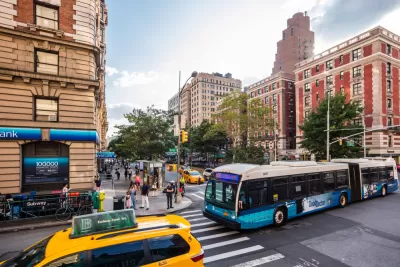Critics of the city's transit assistance program say limiting eligibility to people living at or below the federal poverty line excludes many low-income New Yorkers who depend on public transit.

An article by Niamh Rowe describes New York City mayor Eric Adams' plan to fund the city's Fair Fares transit assistance program, which some critics are calling an inadequate effort to ensure everyone can afford to travel by public transit. According to Rowe, "The plan would cut train and bus fares by half for New Yorkers with incomes at or below the federal poverty level who are not eligible for other transit subsidies or benefits such as those for people with disabilities." The mayor has pledged $75 million to the program for the coming fiscal year, down from $106 million in 2019.
But advocates say the program doesn't go far enough to support New Yorkers who live just above the federal poverty line in one of the country's most expensive cities. According to Danny Pearlstein, policy and communications director of the Riders Alliance, "Two hundred percent of poverty is probably the sweet spot" in New York. Additionally, the program's low visibility means only one-third of eligible New Yorkers are using it. "It can’t be called public transit unless it’s fully accessible to the public," says community organizer Rana Abdelhamid in the article. Advocates like Pearstein and Abdelhamid are calling on the city to raise the budget and widen eligibility for the program.
FULL STORY: The Fair Fares Program Is Staying – for a Few

Maui's Vacation Rental Debate Turns Ugly
Verbal attacks, misinformation campaigns and fistfights plague a high-stakes debate to convert thousands of vacation rentals into long-term housing.

Planetizen Federal Action Tracker
A weekly monitor of how Trump’s orders and actions are impacting planners and planning in America.

In Urban Planning, AI Prompting Could be the New Design Thinking
Creativity has long been key to great urban design. What if we see AI as our new creative partner?

King County Supportive Housing Program Offers Hope for Unhoused Residents
The county is taking a ‘Housing First’ approach that prioritizes getting people into housing, then offering wraparound supportive services.

Researchers Use AI to Get Clearer Picture of US Housing
Analysts are using artificial intelligence to supercharge their research by allowing them to comb through data faster. Though these AI tools can be error prone, they save time and housing researchers are optimistic about the future.

Making Shared Micromobility More Inclusive
Cities and shared mobility system operators can do more to include people with disabilities in planning and operations, per a new report.
Urban Design for Planners 1: Software Tools
This six-course series explores essential urban design concepts using open source software and equips planners with the tools they need to participate fully in the urban design process.
Planning for Universal Design
Learn the tools for implementing Universal Design in planning regulations.
planning NEXT
Appalachian Highlands Housing Partners
Mpact (founded as Rail~Volution)
City of Camden Redevelopment Agency
City of Astoria
City of Portland
City of Laramie





























